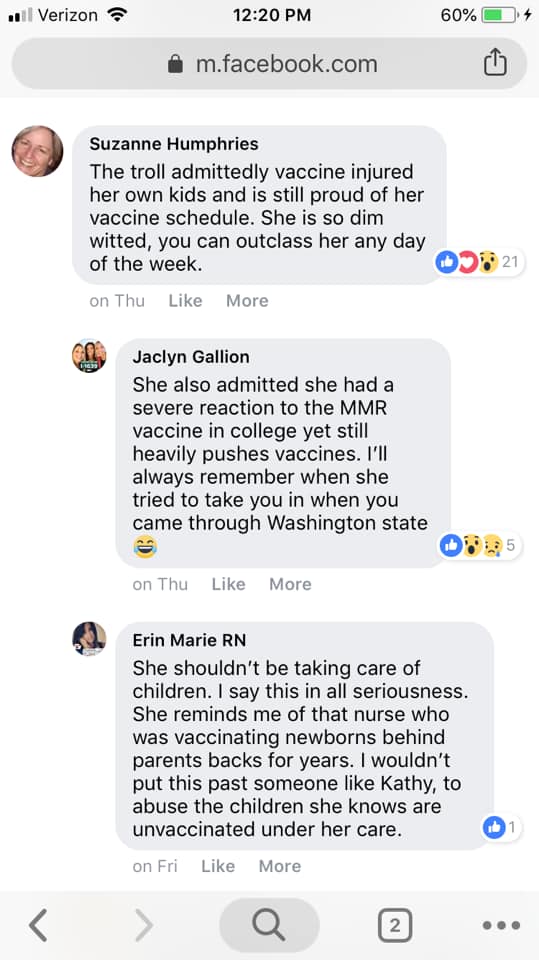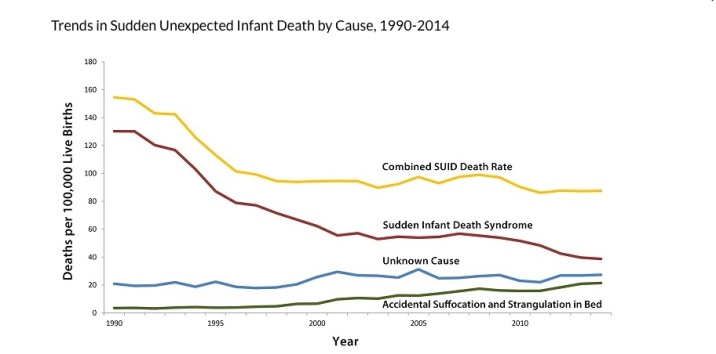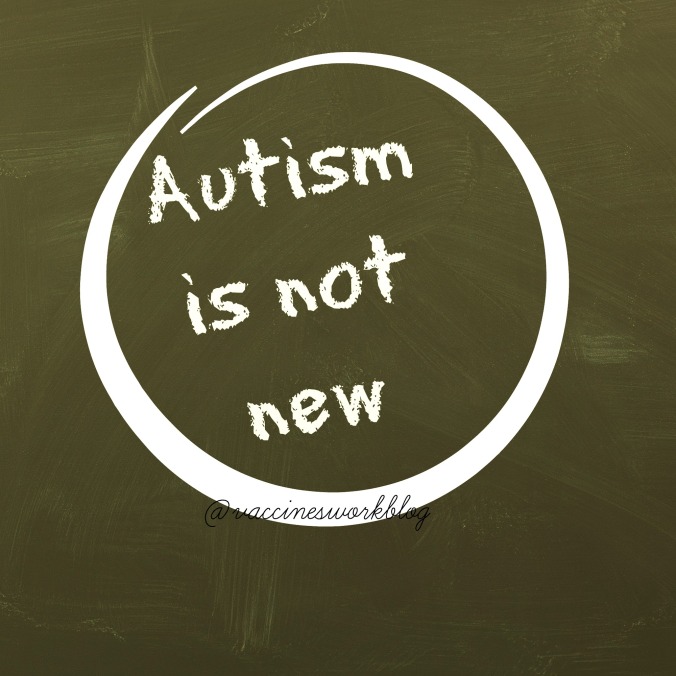I have noticed that antivaxers have a tendency to attack provaxers with what I would call immature vitriol. Vitriol is a term from chemistry meaning caustic but it fits their behavior perfectly. We see it often when they make nasty memes about Dr. Richard Pan or Dr. Paul Offit or my very kind and sweet friend Dorit Rubinstein Reiss, a legal scholar with expertise in vaccine law. Here is an example of the kind of immature and vitriolic posts and memes they make, this one about California Senator, Dr. Richard Pan.

This week, some of the ladies from Informed Choice Washington, the antivax group in my fair state, chose to aim their vitriol at me. This came after I watched two of them, Susie Corgan and Jaclyn Gallion, testify at the latest ACIP meeting. Jaclyn apparently took offense and posted about it on her Facebook wall. [Sidenote: I find it funny that she has me blocked but I still get sent screenshots. Nothing is private online!]

Let’s go through her thread.

So, in this post, Jaclyn posted a link to my last blog post. She thinks I took the photos from her but I actually gathered from friends who found them around the internet. Webster defines “Gaslight” as “manipulate (someone) by psychological means into questioning their own sanity.” I am not sure what she thinks is gaslighting about my comment. I did not call her sanity into question at all.

Next up we have Sandy who used to bug me on Twitter about debating Del Bigtree. I always said I would be fine with doing it if he could promise to not record audio or video. Given what he does with clips, how nasty he can be, why would I trust him not to manipulate my words? She never did set that up. I am not worried about how I look so her comment is very strange. I could make a comment about Del’s looks right now but I am going to rise above.
I did leave a lot out of my post about their ACIP commentary, that is true. I did not feel the need to comment on every single woman’s thoughts.

This made me laugh. I won an award from the CDC, as you can see in my about page, but I had to prove no ties to pharma to qualify. I love how they blindly believe each other without verifying a thing.

I am not sure what Jaclyn means about trolling. I don’t know anything about her children and I never post on other people’s pages unless we are FB friends. I have never posted on Jaclyn’s FB page. As for Chris, she posted more than once about her son and so I made a few comments about him. He and my daughter have the same diagnosis so I figured we could chat. She took great offense and blocked me. I found that confusing since she opened the door by labeling him as autistic. [shrug]
Oh, an I am not a member of the Antivax Wall of Shame. I actually find that group too negative and have never been a member. Go ahead and check their membership.

I am not sure what Drella is talking about. I had several friends help me edit my blog post about them. I did find one more typo today. I would be more than happy to entertain Drella’s edits if she wanted to send them to me. It certainly seems remarkably petty, to me, to make the comment she did with no specifics.
Hi Jack! Always like to see you on my blog. I miss bantering with you, now that you blocked me on Twitter and Facebook.

I am not sure who the Housers are. I will have to look. As for hairy actually, I am quite not hairy. LOL It is telling that Michele, whom I don’t know at all, called me those names. is that really what matters to her? Not the science, just the way someone looks to her? And is she really THAT perfect that she is above criticism?

I don’t appreciate negativity so I have Craig Egan and all his iterations on block. But, hey, thanks for thinking we are that organized that we are one and the same! What a funny comment!

I am not sure how they think I can be a troll if I don’t troll antivax pages. A troll is a person whose seeks out the opposition and posts to argue. For example, when these ladies post on the Spokane Regional Health District Facebook page or the Washington State Department of Health Facebook page, they are being trolls because they always argue with page admin’s points. I am the supporter as I always post a positive, supportive comment. I consider immunization very important but I never go to antivax pages and post. Never. I support the provax, pro-science message, which is the opposite of trolling.
As for my children, what an incredibly low blow for Ms Humphries to make that comment. My children are amazing and beautiful and smart and respectful and amazing. I am incredibly blessed to have a teenager and a tweenager who still enjoy my company and both get all As and Bs in school. One qualifies as gifted and the other is a gifted artist. One plays musical instruments, volleyball, and dances jazz. The older one is on the autism spectrum and her path has not been smooth but she is one of the most incredible people I have ever known in my life and every single speedbump in our lives has led to her being the person she is and I would not change a thing. Not one single thing. She is incredible.
I had a moderate reaction to the MMR in graduate school. My arm swelled up like a tennis ball was in it and it was very painful for about a week. That is not severe but did report it to VAERS and I was told the next MMR might cause a worse reaction. Luckily, 27 years later, I had my titers run and I am still immune!
Erin’s comment is the worst. What kind of person thinks this of people they don’t even know? It’s astounding. I will pray for her soul.

So, now they make fun of my wardrobe from 2015 when I testified in front of the Washington State House Committee on Healthcare at my state capital, Olympia. I wore a brand new abstract floral blouse and navy slacks. Apparently, that was not good enough for them. They didn’t recall a thing that I said but my wardrobe stood out. [snort – you just have to laugh at this level of immaturity]
As for my weight, I am not obese. I wear a size 16 and am tall with broad shoulders. I am not as thin as a rail but my own doctor says I am fine. Why does it matter to them if I am skinny or not? Several well known antivax advocates are quite overweight but that is not why we disagree with them. Their weight is not the issue. Their belief that vaccines cause autism is the issue! Focus ladies! Focus on the issues! Being pretty or not doesn’t matter!

Apparently, Laira does not realize her boyfriend is really just a chiropractor. He is not a medical doctor. He is not a “functional medicine doctor” because he is only licensed as a chiropractor. I love my chiro for helping my extra straight back and neck but I am very glad he does not deviate from straightening joints and backs. Why on earth should I consider a chiropractor knows anything at all about immunology? They are not trained in immunology. They are good for nothing except putting joints back into place.
And, again, I did not listen to all the comments from the ACIP meeting. Feel free to link me to any you want to consider.
Jaclyn, your comment is about as vile as Suzanne’s. Seriously, in what world do you think it is acceptable to say that kind of thing? I see beautiful children daily and help them succeed. None of them are “vaccine injured” and I certainly would never look at one of them and ever think “you are damaged.”

I call a spade a spade. Antivaxers are those opposed to vaccines for reasons not based on sound science. I certainly don’t call all people on the fence about vaccines “anti” because that would not reflect their thinking. And where do I harass people? I never troll antivax pages. Ever. Also, as I pointed out earlier in this post, Chris brought up her son and I then commented. If she had not mentioned him and his issues, I would never have said a thing.
Moral: If you don’t want people to comment on your family, never mention your family.
I am a glass half full kinda gal and it always surprises me when people get so negative and irrational in vaccine discussions. To me, the issues are science and safety studies and efficacy data, not personal issues like looks, what one wore, or one’s weight. If we wanted to make it personal, we could bring up a lot of well-known antivaxers who are obese, smoke, heavily tattooed, ugly, and/or look very ill. But that is beside the point. When we talk about public health, our looks are not the point. The point is what does the science tells us. If you have to deviate from the science and mock a person’s looks and comments, you have lost the debate. You are being a “mean girl.” You are being vitriolic and immature. You are showing the world you have no valid argument on your side and you are so immature that acting like a catty 14-year-old gossiping behind the backs of others is the only choice you have left. What kind of person are you inside?
I am going to always stick to the science. There are no studies which show vaccines to have greater risks than benefits. Vaccines do not cause autism.
Seriously, these ladies are ridiculous.
Have a great day
Kathy























